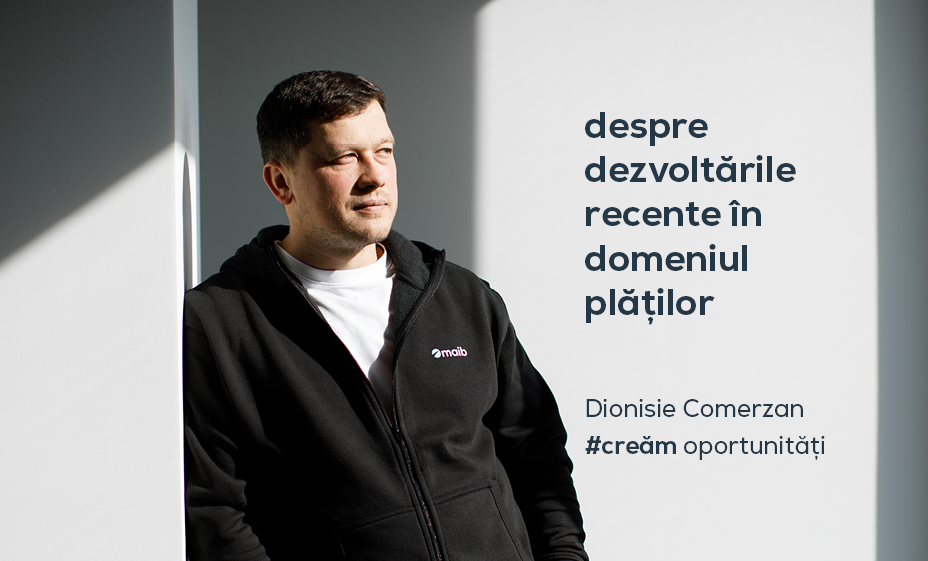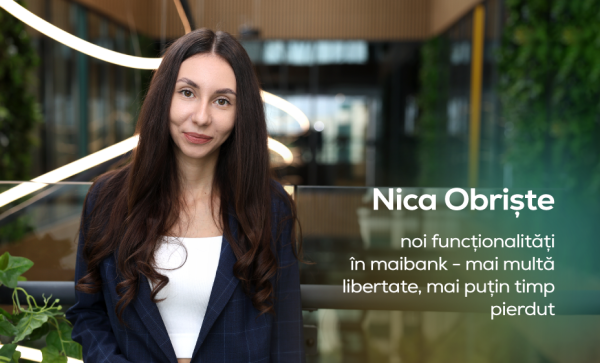Dionisie Comerzan, Orchestra Lead Payments at maib, in an interview with journalist Pavel Zingan.
Dionisie, hello. A year ago we discussed about the maibank mobile app. In the meantime, the bank's customers have been the beneficiaries of many changes and developments. I'm curious how the "insiders" evaluate the change processes?
These changes, including the redesign and refactoring of the maibank app, are positively evaluated in terms of developments. They have resulted in greater technical efficiency, faster development and optimised system performance. The customer experience has been improved due to more intuitive interfaces, and overall feedback indicates a positive perception of the changes.
Could you give more details?
A year ago, the maibank app was a monolithic system, and in the meantime, we have been able to "extract" the processes, turning them into microservices. This gives a new level of flexibility in our work, so the whole system is unaffected when we make changes.
Now it's much more clear. What microservices have been developed?
The Payments team has turned P2P payments and P2P PULLING into microservices, and we are finishing the Utilities service.
P2P payments are straightforward: they are card-to-card payments between individuals. What are P2P PULLING and Utilities?
P2P PULLING is the service where you request a transfer from someone else's card. And Utilities is what we call paying for all utilities (energy, telecom, etc.).
As a maib customer, the strategy of developing microservices separately for greater flexibility is also visible from a customer experience perspective. First of all, this means convenience and time savings. Now, for P2P payments, I just have to enter the card number where I want to transfer money, and I don't have to enter the recipient's name; it is automatically displayed. The same goes for utility bills. Maibank already sees the bill and the amount. I just have to initiate the payment.
However, we still have to work a lot. Soon, in Utilities, there will be scheduled payments, for example. The customer will determine when and what to pay, the app will receive all the information about the payment amount, and the customer will just have to confirm the payment. We can offer this option at the customer's choice if they are ready to pay all utilities automatically.
Last year, we talked a lot about QR code payments. How have things evolved in this area?
We are making progress. One reason for the slow progress is the high level of development of card transactions in Moldova. We compared the payment culture in Moldova and Kazakhstan, where one of our consultants works. In Kazakhstan, QR code payments are developing faster, but the use of payment cards is not so widespread. For the development of QR code payments, we need strong triggers, better commissions, and higher cashback. Let's see what changes will bring about the introduction of the Instant Payment system.
Will it be possible to pay for products and services via Instant Payment?
Yes. Once the system works for transfers between individuals, payments for products and services will be made by sending a QR code or payment link.
These payments would cost less because they would not involve Visa and Mastercard commissions?
Yes, this is one of the reasons why the Instant Payment system was introduced.
If we are already talking about global changes in the market, when will Open Banking be introduced? When will I be able to manage my accounts at other banks through maibank?
I can't give an exact date, but these processes are also under development. You're right, because over time, the financial market will inevitably split into service providers, those with powerful mobile apps, and those customers perceive as trusted places to deposit money. However, in the case of maib, it's complex.
I know that payments are more than just national and international transfers from the mobile app. What else does Payments Orchestra do?
Indeed, Orchestra manages acquiring activities, and maib has a 42% market share. We have the largest POS terminal network in the country, classic POS, Android POS, and virtual POS, and we also have e-comm integrated with Apple and Google Pay, which can be easily integrated on our merchants' web and mobile platforms. We also manage the "Smart City" social project, which promotes the concept of "cashless payments" by accepting card payments in public transport in Chisinau municipality. Another line of business we manage is the collection of funds through self-service terminals and ATMs in MDL and foreign currency at any time, being located in the most convenient points for our customers.
Returning to maibank. What message would you like to convey to the readers of this interview? What awaits maibank customers soon?
We will continue to transform maibank. Customer experience is of great importance to us. Our development agenda is integrating maibank into the SWIFT system, instant QR code payments, and redesign/refactoring of fast transfers. With the introduction of instant payments, we will offer customers a flexible choice. Before making a payment, customers will see what options they will have to transfer money to the recipient - within maib, using Instant Payment or the Visa Alias system. In addition, you will see the payment fee before the payment is made, so the customer has freedom of choice.
Good luck!





